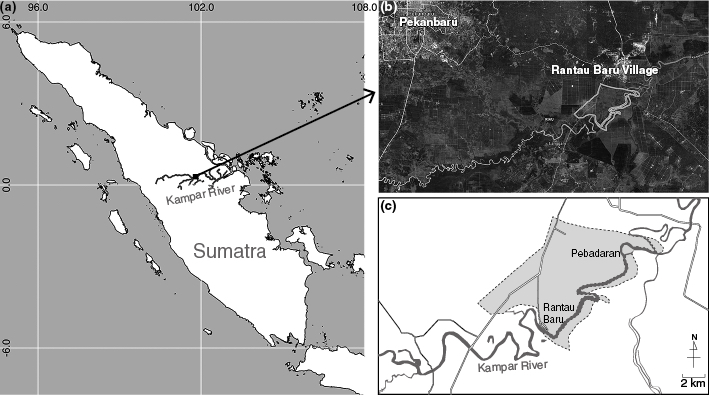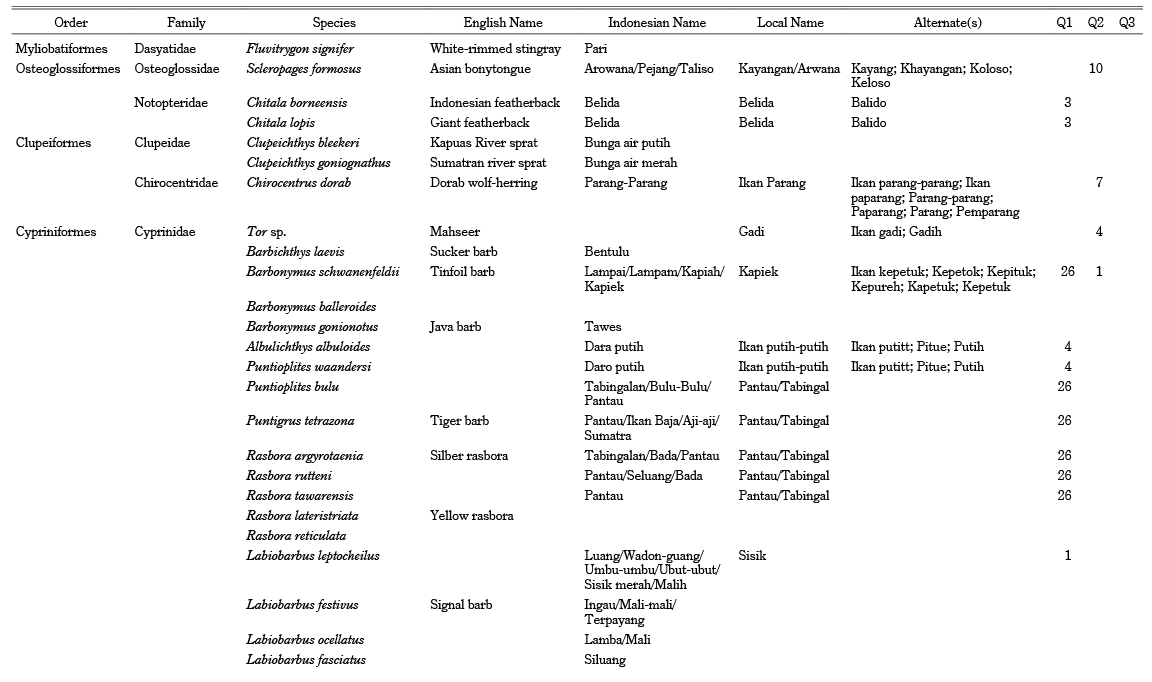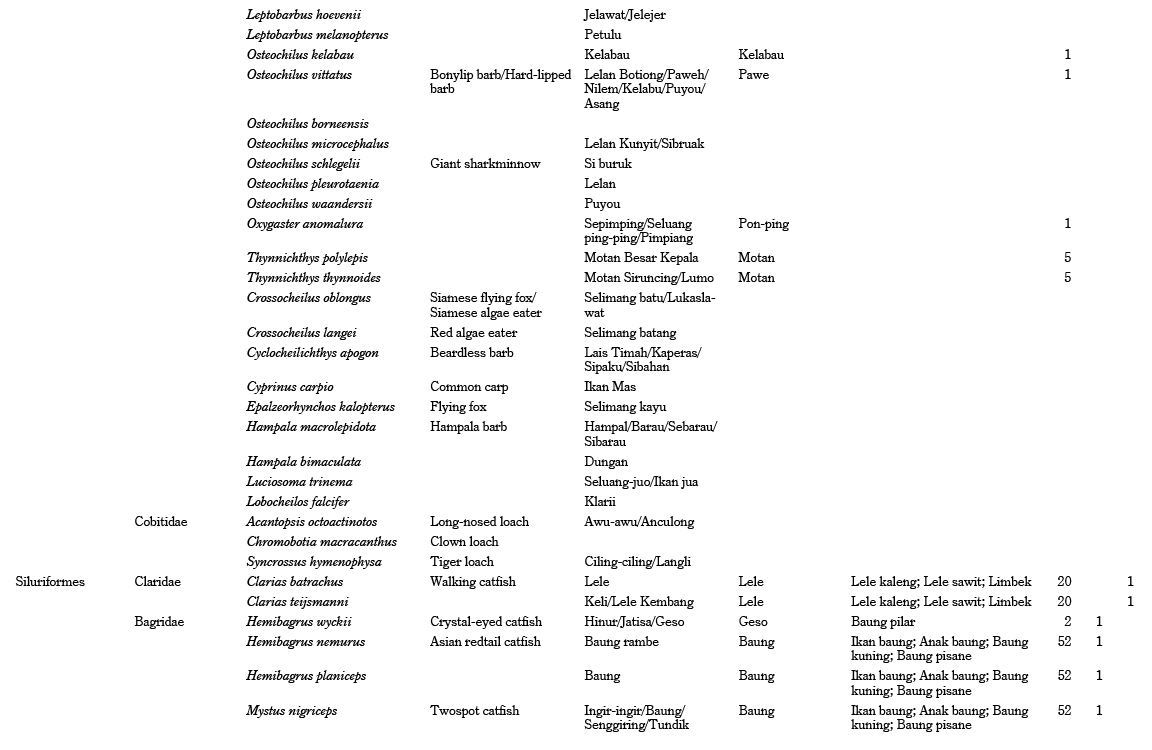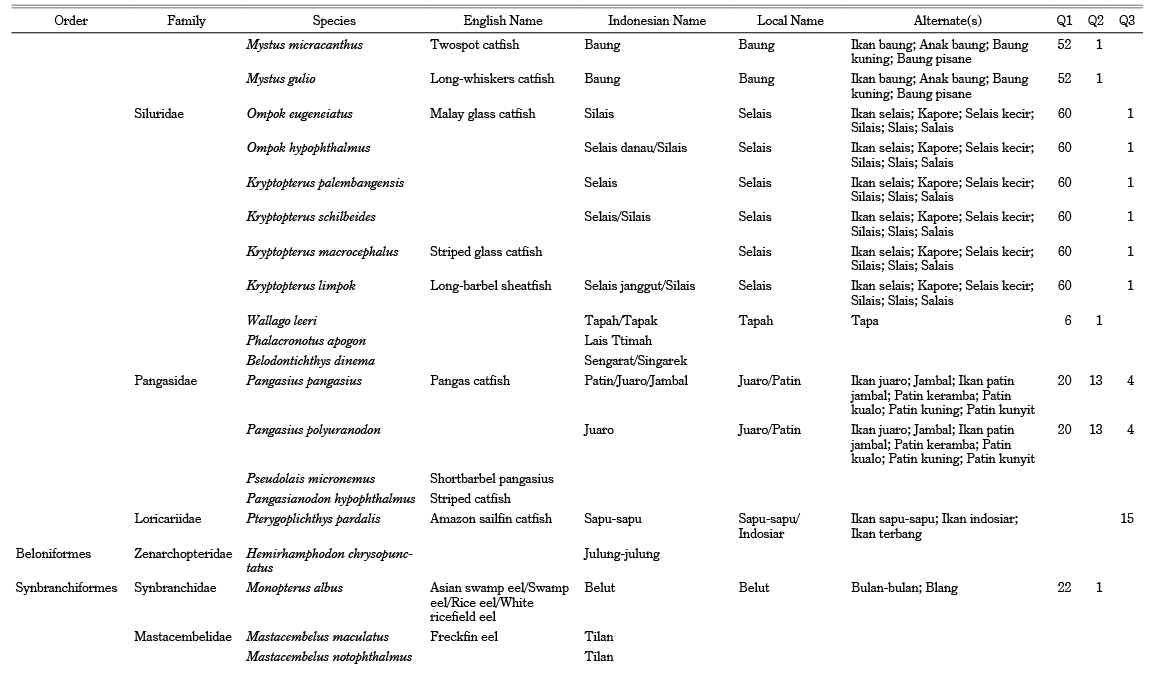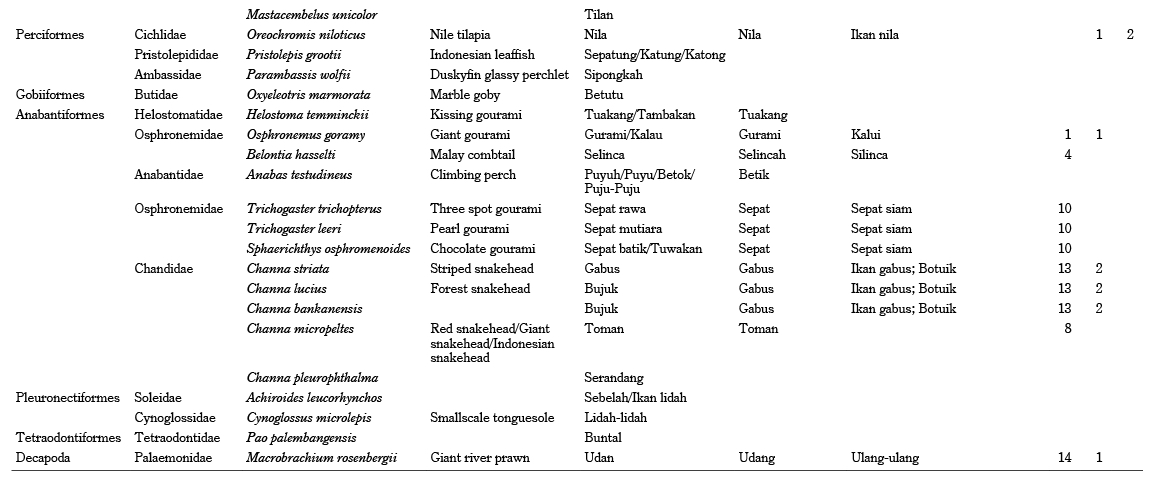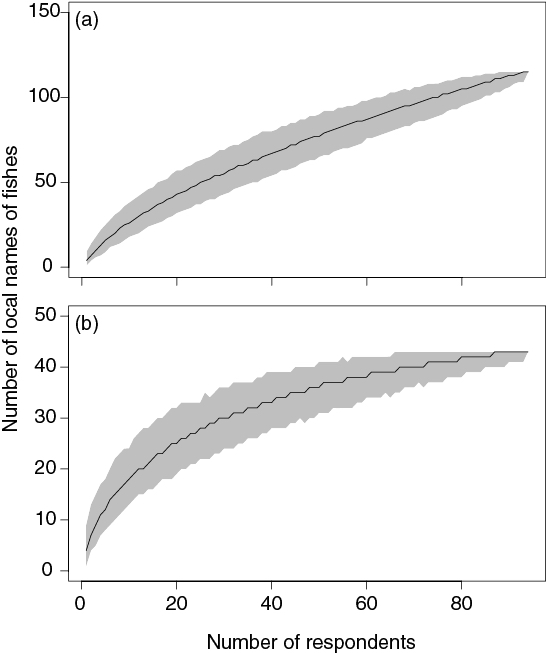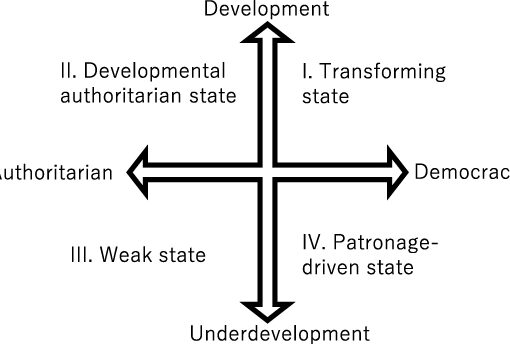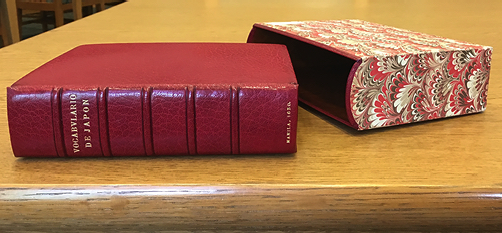Contents>> Vol. 10, No. 3
Local Names of Fishes in a Fishing Village on the Bank of the Middle Reaches of the Kampar River, Riau, Sumatra Island, Indonesia
Nakagawa Hikaru,1 Osawa Takamasa,2 Akhwan Binawan,3 Kurniawati Hastuti Dewi,4 Hasegawa Takuya,5 Desti Zarli Mandari,6 Nofrizal,7 Wahyu Prasetyawan,8 and Okamoto Masaaki9
1 中川 光, Center for Southeast Asian Studies, Kyoto University; Tropical Peatland Society Project, Research Institute for Humanity and Nature, 457-4 Motoyama, Kamigamo, Kita-ku, Kyoto 603-8047, Japan
Corresponding author’s e-mail: hikarunakagawa[at]icloud.com
![]() https://orcid.org/0000-0001-8908-2011
https://orcid.org/0000-0001-8908-2011
2 大澤隆将, Tropical Peatland Society Project, Research Institute for Humanity and Nature
![]() https://orcid.org/0000-0002-6079-1663
https://orcid.org/0000-0002-6079-1663
3 Hakiki Foundation
![]() https://orcid.org/0000-0002-8007-1962
https://orcid.org/0000-0002-8007-1962
4 Research Center for Politics, National Research and Innovation Agency (BRIN)
![]() https://orcid.org/0000-0003-2120-9674
https://orcid.org/0000-0003-2120-9674
5 長谷川拓也, Center for Southeast Asian Studies, Kyoto University
6 Hakiki Foundation
![]() https://orcid.org/0000-0001-9455-3631
https://orcid.org/0000-0001-9455-3631
7 Faculty of Fisheries and Marine Science, Riau University
![]() https://orcid.org/0000-0002-9623-1684
https://orcid.org/0000-0002-9623-1684
8 Universitas Islam Negeri Syarif Hidayatullah Jakarta
![]() https://orcid.org/0000-0002-6887-1238
https://orcid.org/0000-0002-6887-1238
9 岡本正明, Center for Southeast Asian Studies, Kyoto University
DOI: 10.20495/seas.10.3_435
Local ecological knowledge (LEK) originates from people’s experience interacting with ecological systems in their daily lives. LEK therefore encompasses a variety of information on ecological systems and organisms. Knowing the local names of organisms is vital when collecting information from residents and associating a local name with other LEK. The taxonomic name of a biological species follows rules that were developed in the context of conventional natural science, whereas a local name is typically determined by historical and cultural context within a local human community. We aimed to clarify the relationships between local and scientific names of fishes in the middle reaches of the Kampar River, Indonesia. We investigated local names using a questionnaire survey in a fishing village. The villagers spoke a dialect of Malay used in the Kampar River Basin, and the interviewers were born in the area and were able to speak the dialect. We linked 28 local names of fishes to their corresponding scientific names, including three species that may be extirpated species in the local ecological community. More than half of the local names were associated with a scientific name at the genus level or higher. Residents of the settlement closer to the river more often responded with the local names of fishes inhabiting river channels, while those in the settlement farther from the river more frequently responded with the names of fishes that inhabit swamps. Finally, we discuss how information derived from LEK may be useful in ecological conservation even when it is not resolved to the species level.
Keywords: fishing village, folk name, local ecological knowledge, local name, local traditional knowledge, whole house survey
Introduction
Local ecological knowledge (LEK) is knowledge accumulated over a lifetime through observations and hands-on interaction with ecological systems and natural resources, or a cumulative body of local ecosystem knowledge that transcends generations through cultural transmission (Olsson and Folke 2001; Davis and Ruddle 2010; Thornton and Scheer 2012; Berkström et al. 2019). LEK includes organism-specific information such as preferred habitat, abundance, behavior, breeding, and seasonal patterns, and it thus contributes enormously to ecosystem conservation, particularly in situations where scientific data are scarce or unavailable, such as in developing countries (e.g., Hamilton et al. 2012; Berkström et al. 2019) or over historical time scales (e.g., Ogura 2006; Mikami 2008). Local residents are essential to environmental conservation, and combining their LEK with scientific interpretations promotes the success of conservation efforts. A contemporary challenge to achieving sustainable development for local communities and ecosystems is to combine science with local wisdom, but LEK has rarely been shared sufficiently with higher administrative organizations and is seldom reflected in development planning or conservation efforts (Dutton et al. 2009; Glaser et al. 2010; Satria and Adhuri 2010).
One reason that LEK may be difficult to incorporate in conservation practices is its divergence from the terms and concepts used in conventional natural science. LEK is represented in local languages and formulated within the cultural and historical context of a given human community (Atran 1998; Medin and Atran 2004). LEK is subjective; hence, the ecosystem represented by LEK is not a literal depiction of the environment itself but a reflection of the lived experience and memory of a single or multiple human community members. Despite these hurdles, exploring LEK may confer numerous advantages over data collection using conventional techniques. First, LEK can contribute to the formulation of conservation plans and protection of areas in developing and developed countries (Baird 2006; Hamilton et al. 2012; Thornton and Scheer 2012; Berkström et al. 2019). Second, LEK provides long-term, comprehensive information about an environment and represents historical ecosystem dynamics (e.g., Mikami 2008). Third, LEK is related to local resource use; considering humans as part of the environment provides a more holistic depiction of anthropogenic disturbance (e.g., Ogura 2006).
We focused on obtaining the local names of fishes in a fishing village along the middle reaches of the Kampar River in Sumatra. Understanding local names is necessary to collect information on a focal organism from local residents or from existing literature written in a local language, and to associate a local name with other LEK (e.g., Ankei 1989; Castillo et al. 2018). The taxonomic description of a biological species and the determination of its scientific name are guided by international codes (i.e., International Code of Zoological Nomenclature, ICZN; International Code of Nomenclature for algae, fungi, and plants, ICN; International Code of Nomenclature of Prokaryotes, ICNP) (Chairman et al. 1999; Turland et al. 2018; Parker et al. 2019) that were developed in the context of conventional natural science, whereas a local name is typically determined by a morphological or behavioral character based on LEK, and the historical and cultural context of the local human community (Johannes 1992; Atran 1998; Medin and Atran 2004; Haggen et al. 2007). Therefore, the scientific name of a biological species often does not correspond exactly with the local name used for the species by residents. For a taxon with high species diversity, a local name often relates to a scientific name higher than the species level (i.e., genus or family; e.g., Ankei 1989; Ambali et al. 2001; Castillo et al. 2018; but see Roberts and Baird 1995). In addition, a single species may have multiple local names that correspond to various body sizes or to ontogenetic stages during which a fish is important to a community’s livelihood (e.g., Ankei 1989; Castillo et al. 2018). It is therefore crucial to explicitly define the relationships between local and scientific names prior to collecting LEK, especially for conservation practices at the ecological community and ecosystem levels.
Sundaland, which includes Sumatra, Java, Kalimantan (Borneo), and the Malay Peninsula, is a biodiversity hotspot and one of the world’s highest-priority regions for ecosystem conservation (Myers et al. 2000). In Riau Province of eastern Sumatra, natural forest cover has decreased rapidly since the 1980s due to deforestation by national and international industries (particularly oil palm and pulp), residents, and immigrants from northern Sumatra and Java (Mizuno and Kusumaningtyas 2016; Shimamura 2016). Riparian forest and swamp areas that are often submerged during the rainy season (i.e., floodplains) were typically seen as unsuitable for cultivation and thus were less developed relative to other forest areas, but clear-cutting in these areas has increased since the 2000s (Masuda et al. 2016). Floodplains provide critical spawning, rearing, and foraging habitat for river fishes in tropical regions (Amoros and Bornette 2002; Correa and Winemiller 2014). Therefore, floodplain development presents a serious threat to river health, basin ecosystems, and the sustainability of inland fisheries (e.g., Yustina 2016).
The research site, the village of Rantau Baru, is situated in the middle reaches of the Kampar River approximately 200 km from the river mouth, which runs through eastern Sumatra from west to east. The village is surrounded by floodplain, and riparian areas are typically submerged during the rainy season. In addition, large areas of the riverbanks are covered by peat soil. This floodplain has undergone dramatic changes in the past 20 years. In 1996 a large-scale hydroelectric dam (PLTA Koto Panjang) was constructed in the upper reaches of the Kampar River, which has affected seasonal floods (Ahyani and Desma 2020; Aryani et al. 2020). Peat swamps in the research area have been drained since the late 1980s for the development of acacia and oil palm plantations (Shimamura 2016). The drained and dried hinterlands, which were covered by forested peat swamps in the past, now experience frequent fires, and burned areas are often converted to grassland (Shimamura 2016).
We aimed to describe the relationships between scientific and local names of fishes in this area and to understand fish biodiversity in Rantau Baru using questionnaire data. We expected that local fishes would fall into three categories: extant, extirpated, or exotic; hence, we used questions designed to collect this information. We further predicted that the majority of local names would represent a genus or higher taxonomic level and that local names would be biased toward fishes that were easily catchable and/or valuable due to their association with respondents’ experiences.
Materials and Methods
Research Site
We administered a questionnaire survey in the administrative village of Rantau Baru, Pangkalan Kerinci Subdistrict, Pelalawan Regency, Riau Province, Sumatra, Indonesia (Fig. 1). A survey by the village office reported that the village was approximately 100 km2 in area and had approximately 715 residents as of 2018. The main older settlement, Rantau Baru, located on the banks of the Kampar River, had 116 houses (Fig. 1c). This settlement is composed of two administrative sub-villages (Danau Sepunjung and Malako Kecik), but the settlement is customarily called Rantau Baru, the same name as the administrative village. The settlement of Sei Pebadaran is 8 km north of the settlement of Rantau Baru (Fig. 1c); it is a new settlement of 48 houses constructed on hinterland peat soil by the regency government around 2005. At present, tens of immigrants from Java and northern Sumatra live in this settlement to work in surrounding oil palm plantations. Based on a preliminary interview with villagers, although Rantau Baru means “new settlement,” the village is very old, and the details of its history are unknown to the villagers. In general, the settlements of Rantau Baru and Langgam (west of Rantau Baru), which are situated at the confluence of the Kampar Kiri and Kampar Kanan Rivers, are regarded as having the longest history in Pelalawan Regency. It is assumed that the first settlement was established around the confluence, and then people gradually moved downstream. Indeed, the villagers recognize that their ancestors lived in the proto-settlement of Malako Kecik, upstream on the opposite shore of the Kampar River (Fig. 1c), and moved to the present-day village of Rantau Baru at least a few hundred years ago.
Fig. 1(a) Location of the Village of Rantau Baru
Fig. 1(b) Satellite Image of the Area Surrounding the Village of Rantau Baru (Google Maps, https://www.google.co.jp/maps/, obtained March 19, 2020)
Fig. 1(c) Location of the Settlements of Rantau Baru and Sei Pebadaran
The village is typical of fishing villages in the middle reaches of the Kampar River. Almost all households, including those in Sei Pebadaran, fish commercially or for self-consumption in the mainstream Kampar River and its tributaries, as well as oxbow lakes, canals, and swamps near the river. Typical fishing equipment includes fixed traps, gill nets, casting nets, and long lines (Masuda 2012). Local residents hold LEK about the river ecosystem and recognize that the floodplain forests are vital not only as fishing grounds but also as a spawning area (author’s observation). Primary and secondary floodplain forests are relatively conserved around the settlement. Except for some Javanese and Batak migrants, most of the villagers identify themselves as Malay (Orang Melayu). However, this area is in the territory (hutan tanah wilayat) of the Talang (Orang Talang) or Petalangan (Effendy 2002; Masuda 2012), whose livelihoods are largely dependent on swidden cultivation and river fishing. While the villagers acknowledge that their ancestors were called Orang Talang, they now prefer to be called Orang Melayu because the words Talang and Petalangan have negative connotations of “primitive” and “backward” (Effendy 2002; Masuda 2012).
Questionnaire Survey
A questionnaire survey was administered to all 164 houses that had a registered resident living in Rantau Baru between January 27 and February 2, 2020. The interviewers communicated with the villagers in the Malay dialect that is generally used in the Kampar River Basin. From each house, we selected one respondent who was either a head of household (kepala keluarga in Indonesian) or their spouse and conducted a structured interview, in which the questionnaire items were set in advance (Gubrium and Holstein 2001). Note that more than one head of household could be living in one house. The gender of respondents was controlled to achieve an approximately even split across all interviews. The interviewers were seven postgraduate students from the Faculty of Fisheries and Marine Science of Riau University and one NGO staff member from Hakiki who were born in Pelalawan Regency and could speak the Malay dialect of the Kampar River Basin. The interviewers and authors communicated with each other in a mix of Indonesian and English. The interviewers were four males and three females. An interviewer visited each house and conducted a face-to-face interview with a respondent. The questionnaire comprised 101 questions designed to obtain basic information about the respondents and their household, their attitude toward conservation of peat swamp forests, their level of participation in local human community activities, their fishery activity, their landownership status, and their income and assets.
With regard to fish names, we asked the following three questions of residents who reported fishing for consumption or commercial purposes:
1. Tolong tulis jenis-jenis ikan yang anda tangkap dalam 1 tahun terakhir. (Please write down the names of fishes that you have caught in the past year.)
2. Apakah ada jenis ikan yang ditangkap di masa lalu, tetapi dalam 5 tahun terakhir tidak ditemukan lagi? Jika ada, tolong tuliskan nama jenis ikan nya (boleh lebih dari satu). (Please write the name of a fish that you caught in the past but has not been found in the last five years [may be more than one]).
3. Apakah ada jenis ikan yang dulu tidak ada namun sekarang ditemukan? Jika ada, tolong tuliskan nama jenis ikan nya (boleh lebih dari satu). (Please write the name of a fish that was not caught in the past but is caught now [may be more than one]).
Before the final implementation of the questionnaire, we lectured the interviewers on the interview method and objective of our research. We also conducted two preliminary trials in the village in October and November 2019, in which we interviewed about 10 villagers per trial to improve the questionnaire. While some of the subjects also participated in the final version, there were no notable cases where we redid the analyses and removed data from the subjects. We were careful not to show fish names to respondents during interviews so as to avoid leading questions, and the respondents were free to provide any local names that they knew.
Literature Survey
We performed two English literature and three Indonesian literature searches for fish fauna in the middle reaches of the Kampar River (Fauzi 2004; Fithra and Siregar 2010; Aryani 2015; Efizon et al. 2015; Aryani et al. 2020) to obtain a reference species list for known fishes from the area surrounding the village of Rantau Baru. We corrected misidentifications and synonymous scientific names in the literature following J. S. Nelson et al. (2016) and FishBase (Froese and Pauly 2000). We removed from the list records of fishes that had been identified only to the genus level or higher, with the exception of Tor sp., which could not be resolved to species due to taxonomic uncertainty (Pinder et al. 2019). We supplemented the list of Indonesian fish names using literature records of fish from sites upstream and downstream of Rantau Baru and from neighboring rivers (the Rokan, Siak, and Indragiri Rivers) (Siregar et al. 1994; Tjakrawidjaja and Haryono 2000; Iskandar and Dahiyat 2012; Fahmi et al. 2015; Firdaus et al. 2015; Lubis and Windarti 2016; Purnama and Yolanda 2016; Yustina 2016).
Collation of Local and Scientific Names
We compiled all of the spelling variations of local fish names that appeared to be caused by variation in pronunciation or listening error (e.g., Kayang, Khayangan, Koloso, and Keloso are combined as the local name Kayangan/Arwana [Scleropages formosus]; see Table 1). Hereafter, quotation marks indicate local names obtained from interviews. Note that in this paper we provide the spellings of local names as given by the respondents; thus, in several cases the spelling of a local name does not correspond to Indonesian orthography (e.g., “masin” = asin [in standard Indonesian] = salt; “kucir” = kucil [in standard Indonesian] = small). We then connected local names to scientific names by inferring the Indonesian names of fishes. To evaluate the effect of sampling effort on the number of local names identified, both before and after compiling spelling variations, we created rarefaction curves of the number of local names compared to the number of respondents and calculated 95% confidence limits using bootstrap resampling with 999 iterations.
Table 1 Scientific, English, and Indonesian Names of Fishes in the Village of Rantau Baru, along with the Local Names and All Their Alternate(s), and the Number of Person(s) Who Reported Each Species in Response to Questions 1, 2, and 3 (Question 1: fishes caught within the last year; Question 2: fishes caught previously that have not been caught within the last five years; Question 3: fishes caught now that were not caught previously).
Table 1 Scientific, English, and Indonesian Names of Fishes in the Village of Rantau Baru, along with the Local Names and All Their Alternate(s), and the Number of Person(s) Who Reported Each Species in Response to Questions 1, 2, and 3 (Question 1: fishes caught within the last year; Question 2: fishes caught previously that have not been caught within the last five years; Question 3: fishes caught now that were not caught previously). —continued—
Results
We obtained responses from 93% of all households (152/164; male = 74, female = 78). Persons who fished accounted for 77.0% (57/74) of male respondents and 47.4% (37/78) of female respondents. We recorded 38 local fish names following spelling compilation and after removing two names that clearly did not relate to a specific taxon (“Ikan Masin” = salted fish, two cases; “Ikan Pulau” = island fish, three cases) and four names that related to marine fish (“Biang” = Ilisha elongata, three cases; “Ikan Kurau” = Polynemidae spp., one case; “Janggut” = Polynemus dubius, two cases; “Pisang” = Elagatis bipinnulata, one case). Our reference species list for the area, compiled from existing literature, included 96 species belonging to 53 genera, 28 families, and 13 orders (Table 1). The number of local names observed did not reach saturation without compilation (Fig. 2a) but did reach saturation at approximately 70 respondents with spelling compilation (Fig. 2b).
Fig. 2 Rarefaction Curves of (a) Raw Data of the Number of Local Names of Fishes and (b) the Number of Local Names of Fishes Following Spelling Compilation Relative to the Number of Respondents. Lines and gray area show the 50% and 95% confidence limit, respectively, estimated using bootstrap resampling with 999 iterations.
We related 28 local names to scientific names of fish taxa known from the area (Table 1). More than half of the local names were related to a scientific name at the genus level or higher and were also related to multiple scientific names at the species level. For example, “Pantau/Tabingal” was associated with multiple species belonging to the genera Puntioplites or Rasbora. “Baung” referred to multiple species belonging to the genera Hemibagrus or Mystus and included several alternates, such as “Baung kuning” (1/52 cases in Question 1) and “Baung pisane” (2/52 cases in Question 1), although these alternates could not be connected to scientific names. “Selais” referred to multiple species belonging to the genus Ompok or Kryptopterus. “Patin” referred to multiple species of the genus Pangasius, and respondents often gave several alternates referring to Pangasius spp., such as “Juaro” (13/20 cases in Question 1) and “Patin kunyit” (1/20 cases in Question 1), but we could not connect these to scientific names at the species level. “Patin kualo” and “Patin kuning” were named as extirpated species. “Jambal” and “Patin keramba” were named only as exotic species. Several local names such as “Kapore” (=“Selais kecir”) and “Anak baung” represented a certain body size or an ontogenetic stage. Fourteen local names were obviously related to the scientific name of a species for which no confusable species existed, such as a morphologically very similar species; these were “Kayangan/Arwana” (Scleropages formosus), “Ikan Parang” (Chirocentrus dorab), “Gadi” (Tor sp.), “Pon-ping” (Oxygaster anomalura), “Geso” (Hemibagrus wyckii), “Tapah” (Wallago leeri), “Sapu-sapu” (Pterygoplichthys pardalis), “Toman” (Channa micropeltes), “Belut” (Monopterus albus), “Nila” (Oreochromis niloticus), “Tuakang” (Helostoma temminckii), “Gurami/Kalau” (Osphronemus goramy), “Selincah” (Belontia hasselti), and “Betik” (Anabas testudineus).
We connected four local names—“Kayangan/Arwana,” “Ikan Parang,” “Gadi,” and “Belut”—to the scientific names of four fish species, i.e., Scleropages formosus, Chirocentrus dorab, Tor sp., and Monopterus albus, respectively, which had not been recorded in previous scientific research in the area around Rantau Baru (Fauzi 2004; Fithra and Siregar 2010; Aryani 2015; Efizon et al. 2015). The first three of these species were reported as fishes that had been caught in the past but had not been observed in the last five years by respondents (i.e., extirpated). In total, 44 species belonging to 27 genera, 12 families, and 10 orders that were listed in the reference list for the area could not be associated with a local name. Local names for which we found no counterpart in the scientific nomenclature were “Babarak,” “Helang/Olang,” “Ikan watang,” “Jelapo,” “Kapore,” “Seban,” “Tatukul,” “Tepicalan,” “Wajang,” and “Wora.” The majority of known species belonging to Siluriformes (18/21 species) and Anabantiformes (12/12 species) were related to local names, but a number of Cypriniformes (e.g., Crossocheilus spp., Leptobarbus spp., Labiobarbus spp., Hampala spp., and Cobitidae) and several minor taxa (e.g., Dasyatidae, Clupeidae, Mastacembelidae, Ambassidae, and Pleuronectiformes) had no known local names.
Respondents reported 16 and 7 local names in response to Questions 2 and 3, respectively (Table 1). Excluding the previously mentioned three species (“Kayangan/Arwana,” “Ikan Parang,” and “Gadi”), “Patin” (13 cases)—especially its alternates “Patin kunyit” (3 cases) and “Ikan juaro” (2 cases)—was frequently recorded in response to Question 2. “Sapu-sapu” was the most frequent, and “Patin” (4 cases), especially its alternate “Patin jambal” (2 cases), was the second-most frequent response to Question 3.
The taxonomic composition of responses did not differ notably between male and female fishers, with the exception that female fishers referred to the catch of small Cyprinids “Pantau/Tabingal” (15/37) more frequently than did male fishers (11/57). Individuals in Rantau Baru more frequently referred to “Baung,” “Juaro/Patin,” “Pantau/Tabingal,” “Selais,” and “Udang,” whereas individuals living in Sei Pebadaran more frequently responded with “Belut,” “Gabus,” “Lele,” and “Sepat.”
Discussion
While there are various arguments concerning the development process of LEK in relation to conventional scientific knowledge, it is certain that there are differences of language, classification, and context between them (Agrawal 1995; Davis and Ruddle 2010; Thornton and Scheer 2012; Berkström et al. 2019). Therefore, when we try to relate LEK to information collected through conventional scientific methods and apply it to the accumulation of scientific ecological knowledge, we must carefully evaluate the accuracy and stringency of LEK from the perspective of conventional scientific methods (Davis and Ruddle 2010; Berkström et al. 2019). Despite a relatively small sample, our collection of local names in the present study reached saturation, and we therefore suggest that our sampling effort was sufficient to evaluate LEK of fish diversity, at least in the context of compiled local names based on the structured interview approach. Although a small number of respondents discussed processed and marine fish, the majority of local names corresponded to fish taxa that are known to currently inhabit or historically have inhabited the area around Rantau Baru. Therefore, we believe that our questionnaire intent was clearly communicated to the majority of respondents.
We aimed to obtain information regarding extirpated and exotic species using Questions 2 and 3, respectively. However, several respondents answered these questions with local names that other respondents commonly reported, such as “Kapiek,” “Baung,” “Selais,” and “Gabus.” This may reflect changes in fishing location or equipment used over the past five years or a lack of clear interpretation of the differences among Questions 1, 2, and 3. In an interview scenario, it is challenging to explain, in exact terms, the meaning of extirpated and exotic species in the context of ecology, such as to be defined in a scientific text (e.g., Begon et al. 2005), to respondents who have no formal background in ecology. To be clearly communicated, such explanations would need to include explanations of the meanings of species, local populations, and natural distributions in the context of biology as the conventional natural science. Therefore, researchers need to apply appropriate and careful consideration when aiming to understand LEK regarding historical changes in species diversity, including extirpated or exotic invasion (e.g., Lavides et al. 2010).
We connected three reported local names to the scientific names of extirpated species in this study: “Kayangan/Arwana” (Scleropages formosus) (Arwana is a loanword originating from South America; Grenand et al. 2015), “Ikan Parang” (Chirocentrus dorab), and “Gadi” (Tor sp.). These species have not been recorded in the study area since the 2000s, and residents of Rantau Baru indicated that these species previously existed in the middle reaches of the Kampar River. Local residents also recognized several subgroups within “Patin.” The spelling of several local names compiled as “Patin” was similar to the scientific name or a synonym of a species belonging to the genus Pangasius. We suspect that Pangasius juaro (a synonym of Pangasius polyuranodon), Pangasius kunyit, and Pangasius djambal are related to “Juaro,” “Patin kunyit,” and “Patin jambal,” respectively. Interestingly, all three of these species are described as native to Sumatra Island, whereas the local residents defined “Patin kunyit” as the name of an extirpated species and “Patin jambal” as the name of an exotic species. This may reflect temporal changes in the composition of Pangasius spp. in the last several years or cross-swapping in local and scientific names due to miscommunication among and between residents and scientists.
We did not identify the scientific names of species belonging to taxa represented by multiple local names in this study. This was because we lacked sufficient photographs and specimens of fishes from the research site and could not confirm local and scientific names using these methods, as other studies have been able to do (e.g., Ambali et al. 2001; Castillo et al. 2018; Berkström et al. 2019). Therefore, the relationships that we report between 28 local names and their scientific counterparts reflect a highly conservative result; we expect to build upon this as scientific research progresses at the study site. Additionally, we assumed that the local names given by respondents during interviews reflected their own personal experiences. Therefore, it was likely that the responses may have been biased toward fish that were valuable or easily obtained by the respondents. Indeed, the local names of several taxa that are bottom dwelling and small in size, such as Crossocheilus spp., Cobitidae, Ambassidae, and Pleuronectiformes, were not reported in our survey. In addition, while the local name of the stingray (Fluvitrygon signifer) was not reported, we heard Rantau Baru villagers refer to caught ones as “Pari.”
The lack of some fish names clearly shows the limitation of our research method using fixed questions. To comprehend the entire LEK of fish names in the village, the data should be complemented with additional qualitative field research (Baird 2006). Nevertheless, there are some advantages to the quantitative data obtained using a structured questionnaire. First, the data represent the representative fish names that the villagers remember immediately. The data are associated with the villagers’ images of fish and fishing and may encompass gaps in the fish fauna that a conventional scientific investigation will reveal, which are important for planning conservation efforts in collaboration with the villagers (Baird 2006; Hamilton et al. 2012; Thornton and Scheer 2012; Berkström et al. 2019). Second, quantitative data from a structured questionnaire are attained relatively easily in other villages and can be compared among villages. Statistical comparative analyses among some villages in terms of the fish names and villagers’ images provide a macro map of fish distributions and villagers’ images of resource use, which are important complementary data to the qualitative data obtained in detailed field research. It would be fruitful to compare the Rantau Baru data with data from not only other Petalangan or Malay settlements in Pelalawan Regency but also Malay settlements in Kalimantan and the Malay Peninsula in general.
In cases where a large number of local names refer to multiple fish species, caution must be used when applying LEK data to mathematical or statistical analyses that presume species-level identification. For example, models of population dynamics most often assume that inputs reflect monitoring data from a single species (e.g., Beverton 1994), and species diversity indices are typically applied to presence–absence or abundance data obtained from recognized species or detailed operational taxonomic units (e.g., Hill et al. 2003). However, qualitative data from LEK remain useful in ecosystem conservation even when species-level resolution is not available, especially in scenarios where research data are insufficient or non-existent. For example, we found differences in the content of reports of local names between the settlements of Rantau Baru and Sei Pebadaran. Respondents in the former typically responded with the local names of fishes inhabiting river channels or oxbow lakes, whereas those in the latter typically responded with the local names of fishes that prefer swamp habitats. This may reflect the location of the settlement of Sei Pebadaran, which is far from the main stem of the Kampar River relative to the settlement of Rantau Baru, as are the typical habitats where its inhabitants fish (i.e., swamps and small channels). Several previous studies in estuaries and coastal areas have aimed to gain information about habitats, spawning sites, and seasonal patterns of major fishery species from fishers’ LEK (e.g., Knutsen et al. 2010; Hamilton et al. 2012; Berkström et al. 2019). We suggest that this approach is also effective in inland fisheries such as those at our research site.
Accepted: December 15, 2020
Acknowledgments
We thank villagers in the Rantau Baru village for the warm understanding and the kind cooperation to our research. This research was supported by Research Institute for Humanity and Nature (RIHN: a constituent member of NIHU) Project No. 14200117.
References
Agrawal, A. 1995. Dismantling the Divide between Indigenous and Scientific Knowledge. Development and Change 26(3): 413–439. doi: 10.1111/j.1467-7660.1995.tb00560.x.↩
Ahyani, R. F.; and Desma, H. 2020. Disaster Education to Increase Family Resilience (Community Based Participatory Action Research on Post Flood Reconstruction Phase). Proceedings of the 5th International Conference on Education in Muslim Society ICEMS 2019: 30 September–01 October 2019, Jakarta, Indonesia. doi: 10.4108/eai.30-9-2019.2291125.↩
Ambali, A.; Kabwazi, H.; Malekano, L.; Mwale, G.; Chimwaza, D.; Ingainga, J.; Makimoto, N.; Nakayama, S.; Yuma, M.; and Kada, Y. 2001. Relationship between Local and Scientific Names of Fishes in Lake Malawi/Nyasa. African Study Monographs 22(3): 123–154. doi: 10.14989/68206.↩ ↩
Amoros, C.; and Bornette, G. 2002. Connectivity and Biocomplexity in Waterbodies of Riverine Floodplains. Freshwater Biology 47(4): 761–776. doi: 10.1046/j.1365-2427.2002.00905.x.↩
Ankei, Y. 1989. Folk Knowledge of Fish among the Songola and the Bwari: Comparative Ethnoichthyology of the Lualaba River and Lake Tanganyika Fishermen. African Study Monographs 9(1): 1–88. doi: 10.14989/68349.↩ ↩ ↩
Aryani, N. 2015. Native Species in Kampar Kanan River, Riau Province Indonesia. International Journal of Fisheries and Aquatic Studies 2(5): 213–217.↩ ↩
Aryani, N.; Suharman, I.; Azrita, A.; Syandri, H.; and Mardiah, A. 2020. Diversity and Distribution of Fish Fauna of Upstream and Downstream Areas at Koto Panjang Reservoir, Riau Province, Indonesia. F1000 Research 8: 1435–1451. doi: 10.12688/f1000research.19679.2.↩ ↩
Atran, S. 1998. Folk Biology and the Anthropology of Science: Cognitive Universals and Cultural Particulars. Behavioral and Brain Sciences 21(4): 547–569. doi: 10.1017/S0140525X98001277.↩ ↩
Baird, I. G. 2006. Conducting Rapid Biology-Based Assessments Using Local Ecological Knowledge. Natural History Bulletin of the Siam Society 54(2): 167–175.↩ ↩ ↩
Begon, M.; Townsend, C. R.; and Harper, J. L. 2005. Ecology: From Individuals to Ecosystems. Hoboken: Wiley-Blackwell.↩
Berkström, C.; Papadopoulos, M.; Jiddawi, N. S.; and Nordlund, L. M. 2019. Fishers’ Local Ecological Knowledge (LEK) on Connectivity and Seascape Management. Frontiers in Marine Science 6: Article 130. doi: 10.3389/fmars.2019.00130.↩ ↩ ↩ ↩ ↩ ↩ ↩ ↩
Beverton, R. J. H. 1994. Notes on the Use of Theoretical Models in the Study of the Dynamics of Exploited Fish Populations. Beaufort: Marine Fisheries Section, American Fisheries Society.↩
Castillo, T. I.; Brancolini, F.; Saigo, M.; Correa, J. R.; and Baigún, C. R. M. 2018. Ethnoichthyology of Artisanal Fisheries from the Lower La Plata River Basin (Argentina). Journal of Ethnobiology 38(3): 406–423. doi: 10.2993/0278-0771-38.3.406.↩ ↩ ↩ ↩
Chairman, W. D. L. R.; Cogger, H. G.; Dupuis, C.; Kraus, O.; Minelli, A.; Thompson, F. C.; and Tubbs, P. K. 1999. International Code of Zoological Nomenclature. London: International Trust for Zoological Nomenclature.↩
Correa, S. B.; and Winemiller, K. O. 2014. Niche Partitioning among Frugivorous Fishes in Response to Fluctuating Resources in the Amazonian Floodplain Forest. Ecology 95(1): 210–224. doi: 10.1890/13-0393.1.↩
Davis, A.; and Ruddle, K. 2010. Constructing Confidence: Rational Skepticism and Systematic Enquiry in Local Ecological Knowledge Research. Ecological Applications 20(3): 880–894. doi: 10.1890/09-0422.1.↩ ↩ ↩
Dutton, I. M.; Djohani, R.; Sastrapradja, S. D.; and Dutton, K. M. 2009. Balancing Biodiversity Conservation and Development in Eastern Indonesia. In Working with Nature against Poverty: Development, Resources and the Environment in Eastern Indonesia, edited by B. P. Resosudarmo and F. Jotzo, pp. 125–146. Singapore: Institute of Southeast Asian Studies. doi: 10.1355/9789812309600-012.↩
Effendy, T. 2002. The Orang Petalangan of Riau and Their Forest Environment. In Tribal Communities in the Malay World: Historical, Cultural and Social Perspectives, edited by G. Benjamin and C. Chou, pp. 364–383. Singapore: Institute of Southeast Asian Studies. doi: 10.1355/9789812306104-017.↩ ↩
Efizon, D.; Putra, R. M.; Kurnia, F.; Yani, A. H.; and Fauzi, M. 2015. Keanekaragaman jenis-jenis ikan di Oxbow Pinang dalam desa Buluh Cina Kabupaten Kampar, Riau [Diversity of fish species in Pinang oxbow lake in Buluh Cina village, Kampar Regency, Riau]. Prosiding Seminar Antarabangsa Ke 8: Ekologi, Habitat Manusia dan Perubahan Persekitaran 2015: 23–46.↩ ↩
Fahmi, M. R.; Ginanjar, R.; and Kusumah, R. V. 2015. Keragaman ikan hias di lahan gambut Cagar Biosfer Bukit-Batu, Propinsi Riau [Diversity of ornamental fishes in Bukit-Batu Peatlands Biosphere Reserve, Riau Province]. Prosiding Seminar Nasional Masyarakat Biodiversitas Indonesia 1: 51–58.↩
Fauzi, M. 2004. Struktur komunitas ikan sungai Kampar yang dipengaruhi perubahan massa air akibat bendungan PLTA Kotopanjang [The structure of the Kampar River fish community affected by changes in water mass due to the Kotopanjang hydropower dam]. Jurnal Perikanan dan Kelautan 9: 47–60.↩ ↩
Firdaus; Pulungan, C. P.; and Efawni. 2015. A Study on Fish Composition in the Air Hitam River, Pekanbaru, Riau Province. Jurnal Online Mahasiswa Fakultas Perikanan dan Ilmu Kelautan Universitas Riau 2(1): 1–14.↩
Fithra, R. Y.; and Siregar, Y. I. 2010. Keanekaragaman ikan sungai Kampar inventarisasi dari sungai Kampar Kanan [Fishes biodiversity of Kampar River, an inventory from Kampar Kanan River]. Ilmu Lingkungan Journal of Environmental Science 2(4): 139–147.↩ ↩
Froese, R.; and Pauly, D., eds. 2000. FishBase 2000: Concepts, Designs and Data Sources. Los Baños: ICLARM.↩
Glaser, M.; Baitoningsih, W.; Ferse, S. C. A.; Neil, M.; and Deswandi, R. 2010. Whose Sustainability? Top-Down Participation and Emergent Rules in Marine Protected Area Management in Indonesia. Marine Policy 34(6): 1215–1225. doi: 10.1016/j.marpol.2010.04.006.↩
Grenand, P.; Chapuis, J.; Cognat, A.; Christinoi, A.; Davy, D.; Grenand, F.; Jégu, M.; Keith, P.; Martin, E.; Nemo, F.; Pagezy, H.; and Le Bail, P. Y. 2015. Revision of Vernacular Names for the Freshwater Fish of French Guiana. Cybium 39(4): 279–300. doi: 10.26028/cybium/2015-394-005.↩
Gubrium, J. F.; and Holstein, J. A. 2001. Handbook of Interview Research. Los Angeles: Sage Publications. doi: 10.4135/9781412973588.↩
Haggen, N.; Neis, B.; and Baird, I. G. 2007. Fishers’ Knowledge in Fisheries Science and Management. Paris: UNESCO.↩
Hamilton, R.; de Mitcheson, Y. S.; and Aguilar-Perera, A. 2012. The Role of Local Ecological Knowledge in the Conservation and Management of Reef Fish Spawning Aggregations. In Reef Fish Spawning Aggregations: Biology, Research and Management, edited by Y. S. de Mitcheson and P. L. Colin, pp. 331–369. Berlin: Springer. doi: 10.1007/978-94-007-1980-4_10.↩ ↩ ↩ ↩
Hill, T. C. J.; Walsh, K. A.; Harris, J. A.; and Moffett, B. F. 2003. Using Ecological Diversity Measures with Bacterial Communities. FEMS Microbiology Ecology 43(1): 1–11. doi: 10.1111/j.1574-6941.2003.tb01040.x.↩
Iskandar, J.; and Dahiyat, Y. 2012. Keaneka ragaman ikan di sungai Siak Riau [Diversity of fish in the Siak River, Riau]. Bionatura-journal Ilmu-ilmu Hayati dan Fisik 14: 51–58.↩
Johannes, R. E. 1992. Words of the Lagoon: Fishing and Marine Lore in the Palau District of Micronesia. Berkeley: University of California Press.↩
Knutsen, J. A.; Knutsen, H.; Rinde, E.; Christie, H.; Bodvin, T.; and Dahl, E. 2010. Mapping Biological Resources in the Coastal Zone: An Evaluation of Methods in a Pioneering Study from Norway. AMBIO: A Journal of the Human Environment 39: 148–158. doi: 10.1007/s13280-010-0023-6.↩
Lavides, M. N.; Polunin, N. V. C.; Stead, S. M.; Tabaranza, D. G.; Comeros, M. T.; and Dongallo, J. R. 2010. Finfish Disappearances around Bohol, Philippines, Inferred from Traditional Ecological Knowledge. Environmental Conservation 36: 235–244.↩
Lubis, Efawani; and Windarti. 2016. Re-inventarisasi jenis ikan di sungai Sail anak sungai Siak kota Pekanbaru–Riau [Re-inventarisation of fishes in the Sail River, Pekanbaru Regency, Riau Province]. JOM Faperi 3: 1–10.↩
Masuda Kazuya 増田和也. 2012. Indoneshia mori no kurashi to kaihatsu: Tochi wo meguru tsunagari to semegiai no syakaishi インドネシア 森の暮らしと開発土地をめぐる〈つながり〉と〈せめぎあい〉の社会史 [Livelihoods and developments in Indonesian forest: Socio-history of cooperation and conflict of land use]. Tokyo: Akashi Shoten.↩ ↩ ↩
Masuda, K.; Mizuno, K.; and Sugihara, K. 2016. A Socioeconomic History of the Peatland Region: From Trade to Land Development, and Then to Conservation. In Catastrophe and Regeneration in Indonesia’s Peatlands: Ecology, Economy and Society, edited by K. Mizuno, M. S. Fujita, and S. Kawai, pp. 148–184. Singapore: NUS Press; Kyoto: Kyoto University Press.↩
Medin, D. L.; and Atran, S. 2004. The Native Mind: Biological Categorization and Reasoning in Development and Across Cultures. Psychological Review 111(4): 960–983. doi: 10.1037/0033-295X.111.4.960.↩ ↩
Mikami, T. 2008. Climatic Variations in Japan Reconstructed from Historical Documents. Weather 63(7): 190–193. doi: 10.1002/WEA.281.↩ ↩
Mizuno, K.; and Kusumaningtyas, R. 2016. Land and Forest Policy in Southeast Asia. In Catastrophe and Regeneration in Indonesia’s Peatlands: Ecology, Economy and Society, edited by K. Mizuno, M. S. Fujita, and S. Kawai, pp. 19–68. Singapore: NUS Press; Kyoto: Kyoto University Press.↩
Myers, N.; Mittermeier, R. A.; Mittermeier, C. G.; da Fonseca, G. A. B.; and Kent, J. 2000. Biodiversity Hotspots for Conservation Priorities. Nature 403: 853–858. doi: 10.1038/35002501.↩
Nelson, J. S.; Grande, T. C.; and Wilson, M. V. H. 2016. Fishes of the World. Hoboken: Wiley.↩
Ogura Junichi 小椋純一. 2006. Mori to sogen no rekishi 森と草原の歴史 [The transition of grassland area in Japan]. Kyoto Seika Daigaku Kiyo 京都精華大学紀要 [Journal of Kyoto Seika University] 30: 160–172.↩ ↩
Olsson, P.; and Folke, C. 2001. Local Ecological Knowledge and Institutional Dynamics for Ecosystem Management: A Study of Lake Racken Watershed, Sweden. Ecosystems 4: 85–104. doi: 10.1007/s100210000061.↩
Parker, C. T.; Tindall, B. J.; and Garrity, G. M. 2019. International Code of Nomenclature of Prokaryotes. International Journal of Systematic and Evolutionary Microbiology 69(1A): S1–S111. doi: 10.1099/ijsem.0.000778.↩
Pinder, A. C.; Britton, J. R.; Harrison, A. J.; Nautiyal, P.; Bower, S. D.; Cooke, S. J.; Lockett, S.; Everard, M.; Katwate, U.; Ranjeet, K.; Walton, S.; Danylchuk, A. J.; Dahanukar, N.; and Raghavan, R. 2019. Mahseer (Tor spp.) Fishes of the World: Status, Challenges and Opportunities for Conservation. Reviews in Fish Biology and Fisheries 29: 417–452. doi: 10.1007/s11160-019-09566-y.↩
Purnama, A. A.; and Yolanda, R. 2016. Diversity of Freshwater Fish (Pisces) in Kumu River, Rokan Hulu Distinct, Riau Province, Indonesia. Aquaculture, Aquarium, Conservation and Legislation 9(4): 785–789.↩
Roberts, T. R.; and Baird, I. G. 1995. Traditional Fisheries and Fish Ecology on the Mekong River at Khone Waterfalls in Southern Laos. Natural History Bulletin of the Siam Society 43: 219–262.↩
Satria, A.; and Adhuri, D. S. 2010. Pre-existing Fisheries Management Systems in Indonesia, Focusing on Lombok and Maluku. In Managing Coastal and Inland Waters: Pre-existing Aquatic Management Systems in Southeast Asia, edited by K. Ruddle and A. Satria, pp. 31–55. Berlin: Springer. doi: 10.1007/978-90-481-9555-8_2.↩
Shimamura, T. 2016. An Overview of Tropical Peat Swamps. In Catastrophe and Regeneration in Indonesia’s Peatlands: Ecology, Economy and Society, edited by K. Mizuno, M. S. Fujita, and S. Kawai, pp. 123–147. Singapore: NUS Press; Kyoto: Kyoto University Press.↩ ↩ ↩
Siregar, S.; Putra, R. M.; and Sukendi. 1994. Fauna ikan di perairan sekitar bukit Tigapuluh Seberida, Sumatera [Fish fauna in the waters around Tigapuluh Seberida, Sumatra]. In Rain Forest and Resource Management: Proceedings of the NORINDRA seminar, edited by O. Sandbukt and H. Wiriadinata, pp. 67–70. Jakarta: Indonesian Institute of Science (LIPI).↩
Thornton, T. F.; and Scheer, A. M. 2012. Collaborative Engagement of Local and Traditional Knowledge and Science in Marine Environments: A Review. Ecology and Society 17(3): Article 8. doi: 10.5751/ES-04714-170308.↩ ↩ ↩ ↩
Tjakrawidjaja, A. H.; and Haryono. 2000. Keanekaragaman jenis ikan di areal penambangan gambut Perawang dan sekitarnya, kabupaten Bengkalis-Riau [Fish diversity in peat mining area of Perawang and its surroundings, Bengkalis Regency, Riau]. Prosiding Seminar Nasional Keanekaragaman Hayati Ikan, 6 Juni 2000: 55–60.↩
Turland, N. J.; Wiersema, J. H.; Barrie, F. R.; Greuter, W.; Hawksworth, D. L.; Herendeen, P. S.; Knapp, S.; Kusber, W. H.; Li, D. Z.; Marhold, K.; May, T. W.; McNeill, J.; Monro, A. M.; Prado, J.; Price, M. J.; and Smith, G. F. 2018. International Code of Nomenclature for Algae, Fungi, and Plants (Shenzhen Code) Adopted by the Nineteenth International Botanical Congress Shenzhen, China, July 2017. Regnum Vegetabile 159. Glashütten: Koeltz Botanical Books. doi: 10.12705/Code.2018.↩
Yustina. 2016. The Impact of Forest and Peatland Exploitation towards Decreasing Biodiversity of Fishes in Rangau River, Riau-Indonesia. International Journal of Applied Business and Economic Research 14(14): 1043–1055.↩ ↩

